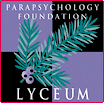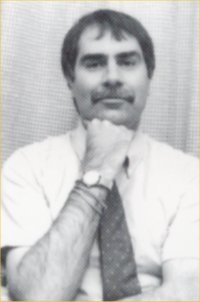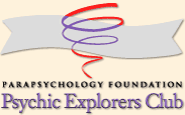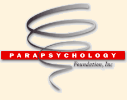 |
 |
| Michael A. Thalbourne, Ph.D.  I came across the area of parapsychology when I was a final-year high school student in 1972, in South Australia. I had been enduring a crisis of religious faith (I had been brought up a Catholic), and one day when I was walking down an aisle in the library there “jumped out at me” James Pike’s book The Other Side, about evidence for life after death. He also mentioned that some evidence ostensibly relevant to survival could also be explained by telepathy between medium and sitter. Thus was born my interest in ESP in particular and parapsychology in general. I came across the area of parapsychology when I was a final-year high school student in 1972, in South Australia. I had been enduring a crisis of religious faith (I had been brought up a Catholic), and one day when I was walking down an aisle in the library there “jumped out at me” James Pike’s book The Other Side, about evidence for life after death. He also mentioned that some evidence ostensibly relevant to survival could also be explained by telepathy between medium and sitter. Thus was born my interest in ESP in particular and parapsychology in general.
Next year at university I wrote a philosophical essay on parapsychology and the mind–body problem, which had to be marked by a psychologist with an interest in the area, since no philosophers there knew anything about parapsychology. That same psychologist became my supervisor in my Honours (fourth) year, and following on from the work with Uri Geller by Targ and Puthoff we put together a 10-trial drawing-reproduction experiment in which close pairs were to be compared with non-close pairs (actually, pairs of people who did not have and who had never had a close relationship with anyone — whom I called “non-close-relaters”). Since no appropriate stimuli were available I systematically used a dictionary to locate, at random, words for depiction as targets. Ultimately I made 180 such targets, and they have proven useful in subsequent experimentation by Dr. Lance Storm and others. A psychological comparison of close- and non-close-relaters revealed a number of interesting significant differences. However, as far as I could tell at the time there were no significant analyses of the ESP data. Ironically, my thesis won a prize for social psychology, and is one of the most often read in the University library. In the following year I commenced post-graduate work, starting with a thorough grounding in the statistical package SPSS. When I re-analyzed my Honours data — and in particular constructed a belief in ESP scale out of a number of individual belief and experiential items — I found extremely strong evidence for the so-called “sheep–goat effect,” but, for some reason, only in pairs who were not-close. It was at this time that I was applying for post-graduate scholarships to do parapsychology, and I experienced my first real taste of prejudice against the area. Initially I was ranked first among all the candidates, but I quickly found that the Commonwealth Scholarships were going to lesser-ranked persons, and I was not offered one, to the surprise of those lesser-ranked people. Traditionally our scholarship-holders went to Oxford or Cambridge, but both psychology departments said that there would be a problem in finding me a supervisor in parapsychology (Robert Thouless offered, but thought he might be too old). The Commonwealth Scholarship administrators were supposed to look all over Britain and find the most suitable university given one’s area, which in this case was Edinburgh, but they apparently did not bother to check this out. The scholarship officer at Adelaide was amazed that I was being overlooked in this way, and could only put it down to the fact that I proposed to do parapsychology; he asked if my research had to do with ghosts! So I was obliged to apply, belatedly, for another scholarship, in this case an internal one offered by Adelaide University itself (the George Murray Scholarship) and in this case I finally succeeded, although the lateness of my application to Edinburgh created some problems, which were finally ironed out. Commonwealth Scholarship holders had their travel costs provided for, but the George Murray provided no funds towards these costs, so I had to apply for a Commonwealth University Interchange Scheme Travel Grant, and fortunately I succeeded in obtaining one. My idealism and commitment to parapsychology caused me to overlook the behind-the-scenes prejudice I had apparently experienced, and to see it as an isolated aberration. In that, I now see, I was wrong. It should also be pointed out that when I wrote to my chosen supervisor, Dr. John Beloff, he greeted me very warmly but had the following to say: I always feel it my duty to sound a note of warning to applicants who want to work in parapsychology. The hard fact is that there are virtually no jobs going in this field and it can prove a handicap in finding jobs in other fields so you should realize that by opting to do your postgraduate work in this area you are taking a risk with your future career. (Personal communication, 22 April, 1977) This warning is as pertinent today as it was 28 years ago. Thus was I duly warned, but I proceeded regardless, deeming parapsychology to be the most important of the psychological sciences, and not looking ahead to the time when I would be seeking a job. For my dissertation I continued using the drawing reproduction technique: I did a further study comparing sheep and goats, a married couple study, a study comparing pairs of people who were strangers to one another and pairs of non-close-relaters, and a methodological experiment the technicalities of which I won’t go into here. Thus, by the end of my PhD, at the University of Edinburgh, I had a reasonable stock of significant results to display. Now at this point there comes a crunch: if a position in parapsychology is available somewhere in the world then the graduate is probably the most qualified to fill it; however, if no places are available, then the graduate is probably not sufficiently trained in anything else to enable them to take alternative employment (which they may not want to do anyway, particularly if they have set their heart on a career in parapsychology.) I was one of the lucky ones — for awhile: I first worked with Erlendur Haraldsson in Iceland and India, and at the time two universities were courting my favor. In the end I went with the McDonnell Laboratory for Psychical Research at Washington University in St. Louis. I became one of that rare breed — someone paid to do parapsychological research full time. We were a happy lab — until one day it turned out that the rumors were true — that James Randi had indeed arranged for two amateur magicians to present themselves to the Lab and pretend to be psychic. Not many people listened to our side of the story — that we were not incompetent researchers but had behaved appropriately towards the two young men — and the Chancellor of Washington University, displeased by the embarrassing publicity, decided that the rest of Mr. McDonnell’s bequest should go to genetics rather than psychical research. The MacLab closed its doors in August 1985. It seemed that no other parapsychological labs had a place for me, and I spent a year doing all sorts of things to keep alive, including substitute teaching of Latin in a high school, teaching an extension course in parapsychology at Washington University, and even, for a time, I was a bartender in a smoky bar, living off my tips. The US social security system supported me for some months, but eventually stopped. I figured that if I returned to Australia the government would look after me whereas in the US one slid into abject poverty. So in 1987 I returned to my native land. Almost immediately I landed a job at the University of Adelaide as a tutor in psychology. I had little time to do research, but most of what I did was parapsychologically oriented. For some lecturers parapsychology was just a laugh, while others found reasons why one shouldn’t bother with it. I gave a departmental seminar (in two universities) called “Signs of Repeatability in Parapsychology,” which was well received. One lecturer said it was the most interesting thing he’d ever heard on the topic; but, he added, it was the only interesting thing he’d ever heard on the topic! Towards the end of my contract I suffered a severe psychological condition of a kind such that, I was told, departments are very reluctant to hire people with it — we were perceived as too potentially unreliable. Thus, after a year or two, it was suggested that I go on the disability support pension, and become an honorary research fellow, which carried no salary but teaching only of Honours students and postgraduates. Thirteen years later, I am still in this working situation. It has actually given me a certain freedom (from undergraduate teaching, marking, and departmental duties), so that I spend most of my time doing research, and I have the reputation of publishing more papers per year than most other members of the department. But make no mistake: it is “work for the dole,” and many other jobs would likely be too stressful for me. In 2001, there was established an Anomalistic Psychology Research Unit (borrowing the name of the same unit at Goldsmiths College), and we have been very productive in research (“we” including Lance Storm, who, in that year, obtained his doctorate under my supervision). We also produce the Australian Journal of Parapsychology. The Head of Department at the time was very supportive. In recent years there has been something of a cloud over our heads, and we feel that our position is more tenuous. The occasional attempts to institute an undergraduate course in parapsychology have met with vehement rejection by the powers that be. The present Head of Department is convinced that psi does not exist and therefore there should be no unit to study what is in essence nothing. He also claims that there is considerable hostility in the university towards our existence. He forbade us to take part in the public Open Day. And he has directed our departmental grants-organizer not to assist us in any way. It seems that we may do research, so long as it is not made public and provided we do not claim that psi exists. Universities all over the world have tended to take attitudes like these, with a very few exceptions, most recently in the UK. So the person who is contemplating a career in parapsychology should be aware of these important and potentially negative factors. It is said by some that the way around this situation is to do one’s PhD in the psychology of belief in the paranormal — where no assumptions are made about the existence of psi — we are merely comparing believers with disbelievers and trying to work out what makes each tick. Certainly papers on this topic have very little difficulty in being published in parapsychological journals, but also, psychological journals are often receptive. The problem I see with this area is that there does not seem to be a consensus as to whether this topic is or is not a part of parapsychology. It is in a no-man’s land — hence the term “anomalistic.” I recall one editor of a parapsychology journal looking at my paper on the psychology of belief in life after death and wanting to send it to a mainstream psychological journal, such as social psychology. I persisted, and published in a parapsychological journal. But when I recently applied for a grant to study the processes underlying our evaluation of coincidence, the grantor asked, why did I bother, since I was not attempting to elicit a psi effect. So this pursuit may or may not be perceived as being parapsychology, and may or may not carry the same stigma. But certainly the grounding that it gives in conventional psychology — personality, attitudes, cognition, even abnormal psychology — is invaluable, though whether such studies throw much light on the psi process is uncertain. The option remaining is perhaps the most unpalatable for someone intrigued by parapsychology and desirous of becoming a psi researcher. And that is, to undertake one’s PhD in an area of conventional psychology (or perhaps physics or even biology), and then, when one has obtained tenure, begin to “come out” with one’s interest in parapsychology. Such a course will probably hold little interest for most would-be students, and a more direct connection with parapsychology may be desired, in which case one must bear in mind the difficulties with employment that will almost certainly plague one. Thalbourne, M. A. (2005) The theory of psychopraxia: A paradigm for the future? In M. A. Thalbourne & L. Storm (Eds.). Parapsychology in the 21st century: Essays on the future of psychical research (pp. 189–209). Jefferson, NC: McFarland. Thalbourne, M.A. (2004). The common thread between ESP and PK (Parapsychological monograph No. 19). New York: Parapsychology Foundation. Thalbourne, M. A. (2003). A glossary of terms used in parapsychology. (2nd ed.). Charlottesville, VA: Puente Press. Thalbourne, M. A. (2001) Measures of the sheep-goat variable, transliminality, and their correlates. Psychological Reports, 88, 339–350. Thalbourne, M. A. (2000). Transliminality and creativity. Journal of Creative Behavior, 34, 193–202. Thalbourne, M. A. (2000) Transliminality: a review. International Journal of Parapsychology, 11(2), 1–34. Thalbourne, M. A. (1998) Transliminality: Further correlates and a short measure. Journal of the Society for Psychical Research, 92, 402–429. Thalbourne, M. A. (1998). Transliminality: Further correlates and a short measure. Journal of the American Society for Psychical Research, 92, 402–419. Thalbourne, M. A. (1996) An attempt to predict precognition scores using transliminality-relevant variables. Journal of the Society for Psychical Research, 61, 129–140. Thalbourne, M. A. (1994). Belief in the paranormal and its relationship to schizophrenia-relevant variables: A confirmatory study. British Journal of Clinical Psychology, 33, 78–80. Thalbourne, M.A. (1981). Extraversion and the sheep-goat variable: A conceptual replication. Journal of the American Society for Psychical Research, 75, 105–119. Thalbourne, M.A. (1979). A more powerful method of evaluating data from free-response experiments. Journal of the Society for Psychical Research, 50, 84–107. Thalbourne, M. A., Bartemucci, L., Delin, P. S., Fox, B., & Nofi, O. (1997). Transliminality: Its nature and correlates. Journal of the American Society for Psychical Research, 91, 305–331. Thalbourne, M. A., & Delin, P. S. (1994). A common thread underlying belief in the paranormal, creative personality, mystical experience and psychopathology. Journal of Parapsychology, 58, 3–38. Thalbourne, M. A., & Delin, P. S. (1993). A new instrument for measuring the sheep-goat variable: Its psychometric properties and factor structure. Journal of the Society for Psychical Research, 59, 172–186. Thalbourne, M.A., & Evans, L. (1992). Attitudes and beliefs about, and reactions to, staring and being stared at. Journal of the Society for Psychical Research, 58, 380–385. Thalbourne, M. A., & French, C. C. (1995) Paranormal belief, manic-depressiveness, and magical ideation: a replication. Personality and Individual Differences, 18, 291–292. Thalbourne, M. A., & Houran, J. (2000) Transliminality, the Mental Experience Inventory, and tolerance of ambiguity. Personality and Individual Differences, 28, 853–863. |
 |

|
 www. parapsychology. org |
||